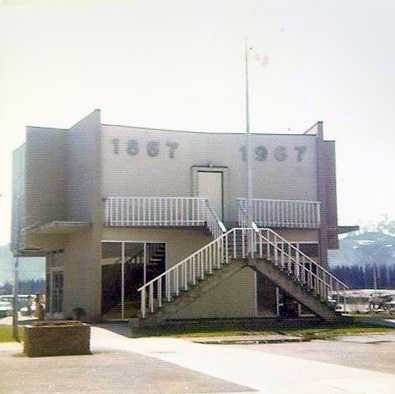
The Kitimat Museum & Archives finds its roots in the community dating back to 1965, as a project designed to celebrate Canada’s Centennial Birthday in 1967.
In January of 1965, a Kitimat Centennial Project Committee, headed by Herbert (Bert) Lange, was established to select a project for Kitimat to pursue as a Centennial Project. The Provincial and Federal Governments were offering funding for Centennial Projects and Kitimat set itself on the road to find a project that fit within the funding guidelines.
Initially the Committee selected a proposal put forward by the Jaycettes. This proposal was to see a square and a pedestrian park constructed in City Centre. As planned the square was to feature two murals, commemorating both Kitimat and Canada, a fountain, benches, gardens and trees.
Municipal Council adopted this project and work began in bringing it together. However, by early 1967, Council reconsidered the square idea and decided that it would be preferable to develop something that could be used throughout the year. By August of that year the Park proposal had been abandoned and new plans were being considered.
The Lion’s Club proposal for a Museum Information Centre was selected over all other suggestions. Among the other proposals was an observation tower for viewing Douglas Channel, a roof for the YMCA swimming pool, a sewage disposal plant, covered walkways for City Centre and a renovation of Hospital Beach.
Why was the Museum proposal selected over all the others? Council decided that it was the plan that would offer the most continuous public use. In the Lion’s Club presentation to the Centennial Committee, then President John Walbergs said: “this fine building will not only stand in the centre of our town to mark this Centennial occasion, but it will also continuously serve the people and industries of the area and also provide a much-needed service to the visitors and tourists who come to Kitimat.”
Walbergs went on to say that “As the town is a mere 14 years old, it is still possible to obtain items which will depict the story of Kitimat from its inception. Also, the town will continue to grow and in the coming years many historic occasions will be captured and preserved at the time they occur.”
By October of 1967 an architect had been hired and in December the property had been purchased from Alcan. The building, originally planned to have a basement, was designed instead as a two-storey structure. The street level was to serve as an archives and information centre, with the upper floor serving as a display area and conference room.
In 1968, a construction contract was awarded and on October 9, 1969, the Museum was officially opened by Mayor Sam Lindsay. From its very beginning, the Museum (a registered non-profit society governed by a Board of Directors) elected from its membership.
When Mayor Lindsay officially opened the Kitimat Centennial Museum, the Centennial Committee presented the Museum with its first artifact - a four-foot totem pole carved by Haisla Artist Sammy Robinson. The pole, originally exhibited in Montreal during Expo '67, can still be seen on display in the Museum’s gallery. Since that time the Museum collection has grown considerably in museological and archival holdings and the visual arts that together tell the story of Kitimats natural and cultural history. The archival collection details many of the events of the Kitimat story. Within the archives is a large photographic collection.
Artifacts on display are accessible to the public, but each year additional steps are taken to increase access while maintaining museological standards as per custodial responsibility. Some artifacts have been added to the Museum’s teaching collection. Access to the archives and photographs is provided through research requests submitted to staff for searches as to the Museum’s holdings. Access is provided to information files, and the researcher is encouraged to review first hand search results – files, photographs, documentary materials. The artifacts for the most part are on permanent exhibit in the lower gallery. The remainder of the collection is in storage.
The permanent exhibits are designed to tell the story of the Power Project with construction of town and smelter. Visitors may also explore the arts and technology of the Haisla First Nation and early settlement of the Valley. Valley prehistory presented through fossils and geological specimens is coming soon. Visitors will be able to view the fossils that have allowed us to determine the age of the Valley and identify the geological processes that were involved in shaping it.
Beyond the permanent exhibits the Museum offers a regular menu of temporary exhibits, approximately eight annually. These range in scope from the Museum in the Classroom art by the elementary school students taking the Museum’s visual arts program in their classroom, to an annual travelling exhibition, to a variety of visual artists showing their artwork and an in-house community history exhibition.
The Kitimat Museum & Archives is a community-based facility. In addition to the exhibit programs, the Museum offers a number of educational and extension programs designed to meet the needs and interests of the local residents. The main thrust of the educational programs is aimed at the elementary schoolchildren. Programs are designed to inter-relate the schoolroom studies with the collections of the Museum. For adults the Museum hosts speakers on a wide variety of topics.
In 2009, the Kitimat Centennial Museum Association officially changed its name to the Kitimat Museum & Archives, and replaced the logo – a bentwood box design – with the current five-colour logo. The new logo – an expression of Mondrian and the Modern Movement, more accurately reflects the town’s original vision and our shared community history.
